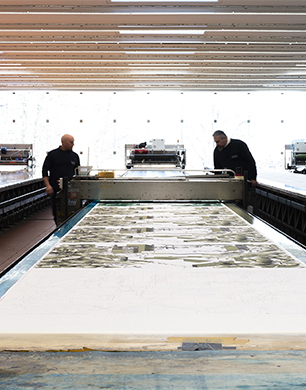 At Ratti, when we talk about fabric processing, we always have in mind concepts such as specialisation, the highest quality, as well as sustainability and innovation in fabric printing techniques. The Guanzate plant is still at the forefront in this respect, including when it comes to environmental protection.
At Ratti, when we talk about fabric processing, we always have in mind concepts such as specialisation, the highest quality, as well as sustainability and innovation in fabric printing techniques. The Guanzate plant is still at the forefront in this respect, including when it comes to environmental protection.
At this site in the province of Como, all stages of production are carefully monitored from spinning, to weaving through to finishing in a dedicated area, while an entire sector is dedicated to fabric printing techniques, whether traditional, such as table printing, or digital, such as ink-jet printing.
Basic Steps From Weaving To Finishing
When it comes to fabric processing, the sequence of steps is very precise and varies from one raw material to another. For example, wool is first sorted and combed, before being processed. Once the top has been made, it is dyed (depending on the designer’s instructions, the spool or the finished fabric can also be dyed) and prepared for spinning. Yarns of different colours are then combined during the twisting stage to obtain a yarn of the desired colour and strength for use in the next stage of weaving, during which the looms, at 700 to 800 strokes per minute, create the fabrics with most requested weaves by fashion houses.
In order to obtain the finished product, there is only one step remaining, that of finishing, a production sequence in which the fabric undergoes a series of treatments aimed at improving the stability, appearance and, last but not least, the softness of the product.
Prints And It’s Different Techniques
However, when we speak of a fabric printing technique, we are referring mainly to a fabric base and the subsequent production cycles: preparation, dyeing of the fabric, steaming for colour fixing, washing and, finally, the ennoblement of the fabric itself.
The hand table fabric printing technique is carried out on tables of varying lengths, covered with a resin-coated canvas onto which the fabric to be printed is secured. The printing panel is moved manually by the operator who spreads the colour, using a spatula. This fabric printing technique is also referred to as wet-on-dry.
Much more recent is the technique of digital printing on fabric, which resembles the operation of a common colour printer in the way it is used. Essentially, this digital inkjet printing technique involves generating droplets of colour that are then deposited on a surface to form a printed image.
Once the fabric has been printed, in order to allow the dye to penetrate and fix, we move on to the steaming stage, then to washing of the fabric and finally to finishing or ennobling the fabric.
For more detailed information, see the in-depth article on textile processing by Ratti now one of the world’s leading players in the production of high-end fabrics and accessories.

